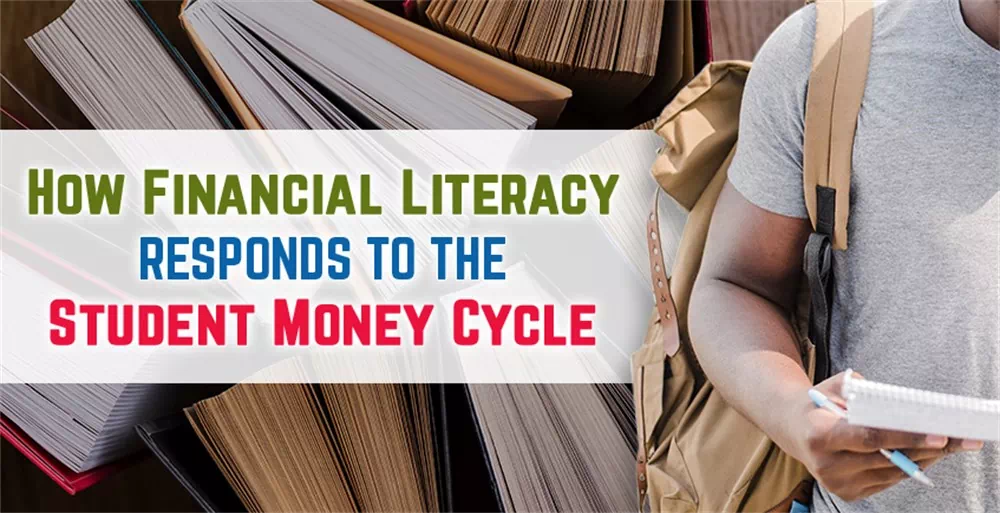When speaking about financial aid, many resources adopt the easiest viewpoint by focusing on the initial loan counseling and ending with repayment. Not to mention, the beginning and end of loan disbursement are the times when students most seek out assistance. However, in between those two milestones lie years of shifting financial circumstances and outlooks, and in order to secure financial health during and after school a responsive and proactive approach to personal finance education is required.
In order to secure financial health during and after school a responsive and proactive approach to personal finance education is required.
College provides an endless array of financial experiences, from the credit-card-funded Spring Break trips to Panama City, through the first apartment, into their first car, and following through to saving and funding a wedding and first baby. When considering the wide expanse of the entire student money cycle, reacting and responding to each particular circumstance and financial upset is too much to ask of any financial aid administrator; likewise, personal finance courses and seminars are only helpful to those enrolled; online information has risks of misinformation or (worse) scammers. In the end, providing an online platform that is able to learn and respond to the shifting student money cycle is the most effective way to deliver a constant, adaptive, engaging financial education - and not just to students, but (providing the platform has broad enough topics) to faculty and staff as well!
Initial Money Worries
Initially, freshman finances are undoubtedly centered around the annual loan experience. With 70% of students taking out loans,1 and each requiring individual loan counseling, disbursement, and guidance, the task is daunting no matter the size of the school. Aside from explaining the entire loan experience, working to ensure proper money management of available funds is an additional, yet vital step. Furthermore, surveys suggest that it is a mistake to assume parents and/or high schools have provided a foundational financial education to students.
The Challenge: Engagement
Students often lack an initial financial education and studies show that students are not fully engaging with the annual loan counseling with 65% of borrowers misunderstanding or being surprised by some aspect of the loan process.2 Some students report no memory of the counseling whatsoever while 40% of borrowers deny having loans altogether!3 Providing the counseling is necessary, but remembering the counseling is vital.
The Financial “Firsts”
The middle years of college are when students are most exposed to delicate financial decisions, and least likely to reach out for assistance. Students, now comfortable with their college lives, fully settle into the college experience. Nights out with friends test finances. Ramen noodles become the diet. First cars are bought. Spring break trips are financed. Apartments are rented. Furthermore, major lifestyle changes are possible with shifting majors, transferring schools and new interests.
The Challenge: Responsiveness
Having the students interact with the Financial Aid Office in order to get their funds is relatively easy in comparison to attempting to provide an overall financial education - or one that literally responds to the immediate concern or stress of the student. In order to be of service, the information needs to be effective, accurate, immediate and responsive.
Repayment
Eventually, the time to leave school comes. Whether facing graduation or leaving school without a degree, the loans must be repaid. Getting the necessary information of how to handle loans, wrangle servicers, avoid scams, find and use reputable resources, and where and how to reach out for help, into the hands of each student eager to embark on the rest of their lives continues to be a chore. Surveys report 65% of borrowers are unsure how much interest they will be paying on their loan4 suggesting some important repayment information is not being effectively communicated. Furthermore, defaulted loans have dire consequences for schools as well as students.
The Challenge: Default Rates
The symbiotic relationship between the school and the student is rarely understood from the school’s point of view. Much attention is paid to the burden students carry but less is given to the stress of school’s working to keep retention rates high and default rates low.5 For students the results of default or delinquency are often related to additional financial problems, with 46% of borrowers in default had a credit card in collections or delinquent.6 The increased risk to the financial security of the graduates adds to the risk of defaults to the school.
And Beyond...
Just because the student’s college education is finished does not mean the school’s responsibility to the student has ended, and vice versa. Students with loans are inevitably tied to the institution for years to come. Graduates now face major purchases, such as mortgages or graduate degrees, and milestones, like weddings and births. While responding to students’ ongoing money stresses is a goodwill effort, schools receive a beneficial byproduct when reaching out to alumni for donations
The Challenge: Ongoing Education
For students,there is seemingly an endless amount of information and guidance dealing with their student loans. However, a fundamental financial education that prepares them for retirement, investing, APR’s and being a wise consumer is less widely available though wanted with 48% of Americans believing a financial education should be required.7 Maintaining communication, and continuing to be a valuable resource for graduates ensures a direct connection with each alumni, and maintains a positive and useful post-college relationship.
Solution: Online Financial Literacy
The strength of an online financial literacy platform is evident when compared to the challenges laid out above. Using an adaptive, online platform each student is able to receive a personalized, responsive financial education.
Solution To: Engagement
The iGrad platform works to keep students engaged and involved with their financial education with a multimedia presentation and incorporating gamification to increase attention and retention of the information.
Solution To: Responsiveness
The proprietary behavioral algorithm driving iGrad is designed to read and respond to each user’s interactions with the platform, creating an endless flow of tangential information and further learning opportunities.
Solution To: Default Rates
The most effective defense against rising default rates is a financial education that prepares the student for the realities of repayment and the importance of budgeting to compensate. By providing a strong foundation, the graduate is less likely to be surprised by the monthly payments and less likely to engage in risky financial behaviors ultimately producing a responsible graduate who is able to pay their loan payments fully and on time.
Solution To: Ongoing Education
Maintaining the resources to alumni as they continue into their post-collegiate lives creates a useful connection. By continuing to be a trusted, reliable resource, able to respond to the ongoing financial upsets alumni face, an institution creates a pathway for a lengthy and reciprocal alumni relationship.
1. Student Loan Debt Statistics 2018
2. High Debt, Low Information: A Survey of Student Loan Borrowers
3. Effective Counseling, Empowered Borrowers
4. Student Debt: A Growing Problem for All Employees
5. Why are cohort default rates important?
6. Small Loans, Big Risks
7. Merrill Edge Report - Spring 2017








